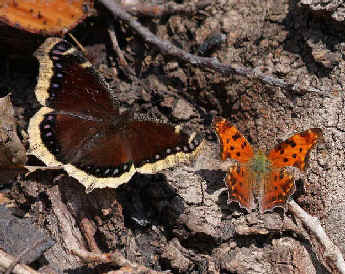 A
List and
A
List and
Photo Gallery
of
Butterflies
of
Eastern
NORTH
AMERICA
including those during
Focus On Nature Tours
in North Carolina,
on the Delmarva Peninsula,
and elsewhere in the East
With LINKS to LISTS of: MOTHS
and DRAGONFLIES & DAMSELFLIES
This List of eastern North American
Butterflies compiled by Armas Hill
(with some input by the staff from the
Howell Woods Environmental Learning Center
in Four Oaks, North Carolina)
Photo at upper right: a MOURNING CLOAK (left)
& EASTERN COMMA (right)
Photo below: a RED-SPOTTED PURPLE
(upper photograph by Doris Potter; lower photo by Marie Gardner)
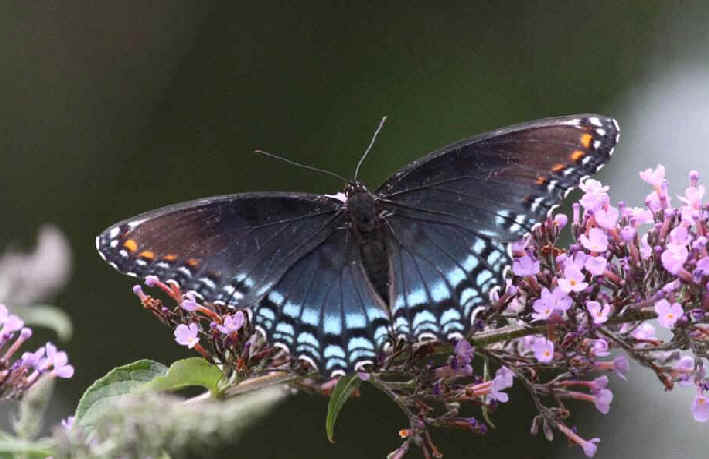
Codes:
Numbers noted as
(PE:xx)
refer to plates in the
Peterson Field Guide to Eastern Butterflies,
by Paul Opler & Vichai Malikul
(1998 edition)
Numbers noted as
(K:xx)
refer to pages in the
Kaufman Focus Guide to Butterflies of North America,
by Jim Brock & Kenn
Kaufman
Numbers noted as
(W:xx)
refer to pages in
"Caterpillars of Eastern North America"",
by David Wagner,
2005.
DE: occurs in Delaware
FL: occurs in Florida
MA: occurs in Massachusetts
MD: occurs in Maryland
ME: occurs in Maine
NC: occurs in North Carolina
NH: occurs in New Hampshire
NJ: occurs in New Jersey
PA: occurs in Pennsylvania
VA: occurs in Virginia
The seasonal occurrence in the list given is that for southern Pennsylvania. To the north or
south, there may be some variation.
(i/E): species introduced from Europe
Species classified as GLOBALLY THREATENED:
(t1): critically endangered
(t2): endangered
(t3): vulnerable
(nt): a near-threatened species globally
(ph): species with a photo in the FONT website
A truly superb book about the butterflies of eastern North America is "Butterflies
of the East Coast, an Observer's Guide" by Rick Cech & Guy
Tudor, 2005. Books and photographs don't come much better.
This book is a source for some of the information included in this list.
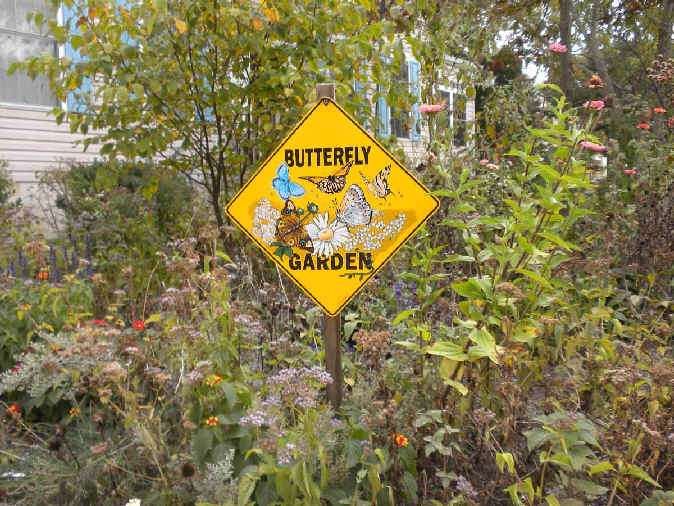
In a way, of course,
butterflies can be almost anywhere,
but places such as this,
Mildred's butterfly garden in Cape May Point, New Jersey,
can be very good for seeing them.
(photo by Rise Hill).
Links to Butterfly Groupings in this List:
SWALLOWTAILS
Whites & Sulphurs
GOSSAMER-WINGS
Harvester,
Coppers Hairstreaks, Elfins
Blues,
Azures
METALMARKS
BRUSHFOOTS
Snout
Fritillaries Crescents & Checkerspots
Question Mark, Commas
Tortoiseshells & Mourning Cloak
a mis-named Admiral & the
Ladies Buckeyes, Peacock
Admiral, Viceroy Purplewings, Daggerwing, Leafwings
Emperors, Monarch, Queen
Satyrs & Wood-nymphs
Pearly-eyes, Brown,
Arctics
SKIPPERS Grass
Skippers
Other Links:
Upcoming FONT Birding & Nature Tours in North America
(including. North Carolina, and Delaware, Maryland, & Virginia)
Upcoming FONT Birding & Nature Tours Elsewhere
FONT Past Tour Highlights
Birds during FONT
Tours in North Carolina Hummingbirds of the Americas
A List & Photo Gallery of North American Birds, in 6 parts
Other Lists & Photo
Galleries in this Website:
Eastern North
America Moths Eastern
North America Dragonflies &
Damselflies
Eastern North America Wildflowers & Other Plants
(with host
plants for butterflies & moths)
Eastern North America Mammals (Land & Sea)
noting those during FONT Tours
Eastern
North America Amphibians &
Reptiles Eastern North America Marine Life
Other Lists of Butterflies, elsewhere in the world
Alphabetical Directory of Butterflies by Genus
with Photos in the FONT
Website
Directory of Photos in this Website
HERE'S A LINK TO CHAD KREMP'S WEBSITE RELATING TO PLANTS
THAT ATTRACT BUTTERFLIES:
http://www.kremp.com/butterfly-flower-gardening-articles.htm

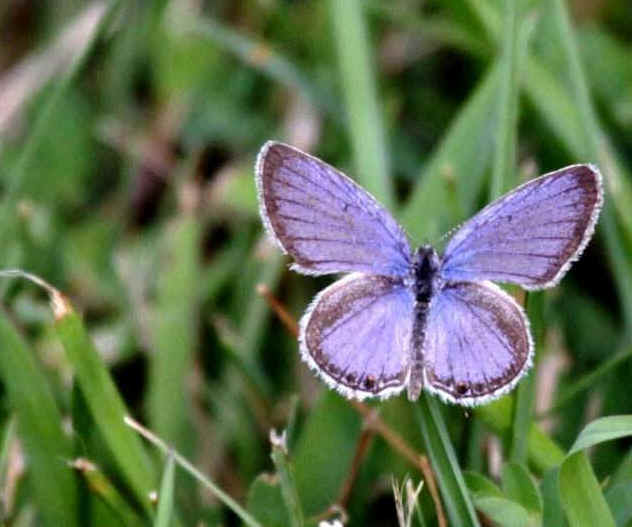
An Eastern Tailed-Blue
(photo by Marie Gardner)
SOME COMMENTARY REGARDING BUTTERFLY IDENTIFICATION:
"Get a guidebook, take a few years, and
you'll still make mistakes. Butterfly identification has an initial, deceptive
simplicity.
Individuals in a species vary naturally, an eyespot slightly larger, a color
brighter.
Males and females of a species can be strikingly dissimilar.
So can genetic morphs or forms within a gender.
In a single species, butterflies that live in a range of habitats can vary in
appearance and produce different populations or geographical races, each better
adapted to its environment.
Species can also produce generations of distinct morphs in the same place at
different times of the year.
One Tiger Swallowtail is black. On the same
flower, another Tiger Swallowtail is yellow.
Another species produces red butterflies in the wet season and blue in the dry.
A species darkens in response to air pollution.
A species gains an eyespot. A species loses one."
The above commentary taken from the book, "An Obsession with
Butterflies", by Sharman Apt Russell (a wonderful read).
REGARDING A STUDY RELEASED IN AUGUST 2012 RELATING
CHANGES IN BUTTERFLY POPULATIONS IN MASSACHUSETTS:
The Harvard study, conducted over 2
decades, found that populations of warm-climate-adapted butterfly species grew
by as much as a thousand fold, while those of cold-climate-adapted species that
have long been native to Massachusetts declined substantially, by as much
as 90 per cent.
Data was collected during the 2 decades by the Massachusetts Butterfly Club,
an amateur naturalist group that tracks butterfly sightings and numbers.
17 of 21 northern butterfly species in Massachusetts were found to be
declining, including the Atlantis Fritillary and the Acadian
Hairstreak.
12 southern butterfly species, which were rare or unseen in Massachusetts
in the 1980s & 1990s, were found to have increased tremendously, especially
in warmer parts of the state. Such species include the Zabulon Skipper
and the Giant Swallowtail.
For most of the species in the study, climate change seems to be a stronger
cause than habitat change.
Butterflies:
SWALLOWTAILS
- Zebra Swallowtail (ph) ______
(PE:5)
(K:25) (W:82) DE MD NC NJ PA
VA apr-aug
Eurytides marcellus
Host plants for caterpillars:
mainly Common Pawpaw, Asimina triloba, which
occurs in rich bottomland woods north to the upper Chesapeake Bay.
Further south, pineland/savanna pawpaws are used: Asimina reticulata,
Asimina tetramera incarna
Adult food: milkweed, ironweed, blueberry, blackberry
Notable: in PA: 2015: upper Bucks County May 8 (a single)
A good place to see the Zebra Swallowtail in northeastern North America,
as we have during FONT tours, is the Elk Neck State Park in
Maryland.
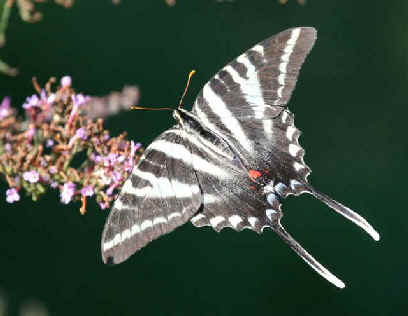
Zebra Swallowtail
(photo by Marie Gardner)
- Pipevine Swallowtail (ph) ______
(PE:5) (K:27) (W:77) DE MA MD NC NH NJ PA VA
apr-oct
Battus philenor
Host plants for caterpillars: Pipevines (in the Aristolochia
genus), including Dutchman's Pipe, A. macrophylla, or durior, Virginia
Snakeoot, A. serpentaria.
Adult food: thistle, teasel, milkweed, ironweed
Notable: in PA: 2015: upper Bucks County Jul 7 (a pair)
In southern NJ: in 2015, during the Cumberland County Butterfly Count, on
June 24, there was 1 Pipevine Swallowtail.
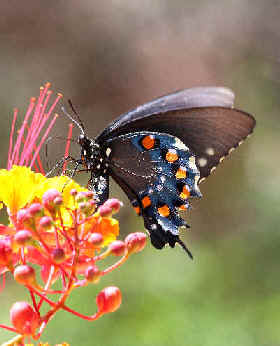
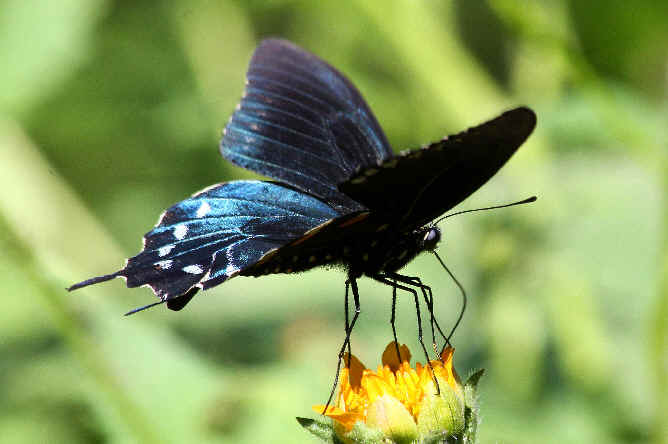
Pipevine Swallowtails photographed during a FONT tour
(photos by Doris Potter)
- Polydamas Swallowtail (ph) ______
(PE:5)
(K:37) (WL76) FL
Battus polydamas
Host plants for caterpillars:
Marsh's Dutchman's Pipe, Aristolochia
pentandra, Virginia Snakeroot, Aristolochia serpentaria
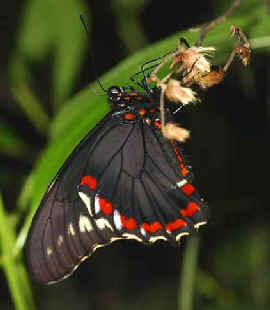
Polydamas Swallowtail
- Eastern Tiger Swallowtail (ph) ______
(PE:7) (K:21)
(W:79) DE FL MA MD NC NH NJ PA
VA may-sep
Papilio glaucus
Dark female Eastern Tiger Swallowtails mimic the toxic Pipevine
Swallowtail.
Host plants for caterpillars:
especially Tuliptree, Liriodendron tulipifera,
wild cherries (in the Prunus genus), ash (in the Fraxinus genus), Water Ash,
Ptelea trifoliata. Also, in the Deep South: Sweet Bay, Magnolia virginiana
Adult food: thistle, teasel, Joe-pye weed, dogbane
In northern NJ: in 2015, during the Great Swamp Area Butterfly Count, there
were 10 Eastern Tiger Swallowtails.
In southern NJ: in 2015, during the Cumberland County Butterfly Count, on
June 24, there were 2 Eastern Tiger Swallowtails.
In PA: in 2015, during the Hawk Mountain Butterfly Count, on
July 11, there were 108 Black Swallowtails.
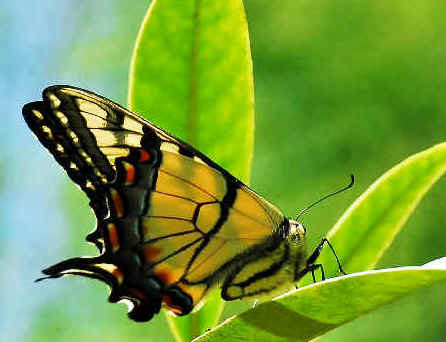
Above: an Eastern Tiger Swallowtail
photographed in North Carolina in May 2015
(photo by Amanda Hendricks)
Below: in one picture, the two forms of the Eastern Tiger Swallowtail
The male has only the yellow form.
The female can be either the yellow or the black form (as shown here).
(above photo by Howard Eskin)
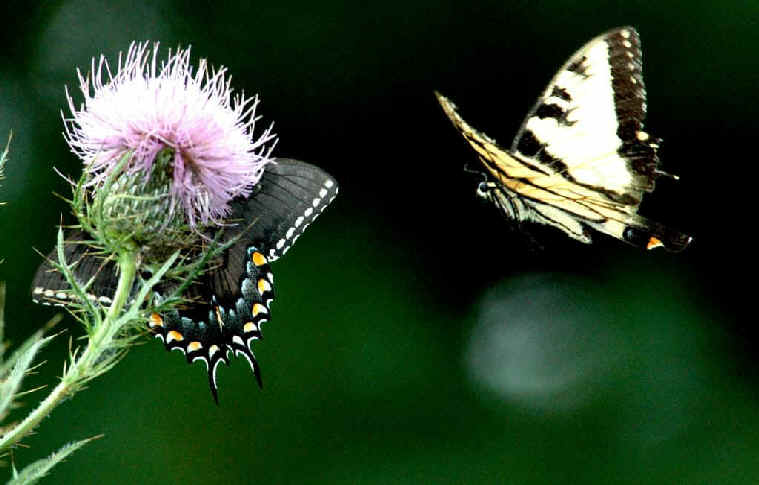
Below: the yellow form of the Eastern Tiger Swallowtail.
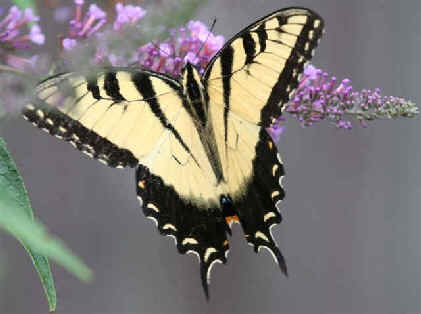
Below, two photos of dark female Eastern Tiger Swallowtails.
The butterfly in the lowest photograph is
"intermediate".
(both photos below, and the one immediately above by Marie Gardner)

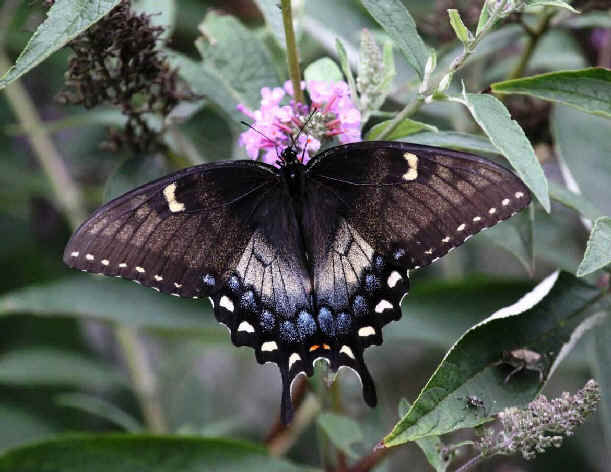
- Canadian Tiger Swallowtail (ph) ______
(PE:7) (K:21) MA
ME
NH
PA
Papilio canadensis
The single-brooded northern populations of Tiger Swallowtails in eastern
North America were recognized in 1991 as a separate species, the Canadian
Tiger Swallowtail.
And still more recently, in 2002, a large single-brooded spring population
centered in the Appalachians, with reduced hindwing blue clouding, was said
to be a sibling species, the Appalachian Tiger Swallowtail (the next
species in this list).
Host plants for caterpillars: birch (in the Betula genus), aspen (in the
Populus genus), and black cherry (in the Prunus genus).
An interesting note: the Tuliptree, a common host for the Eastern Tiger
Swallowtail (above), is toxic to the Canadian Tiger
Swallowtail.
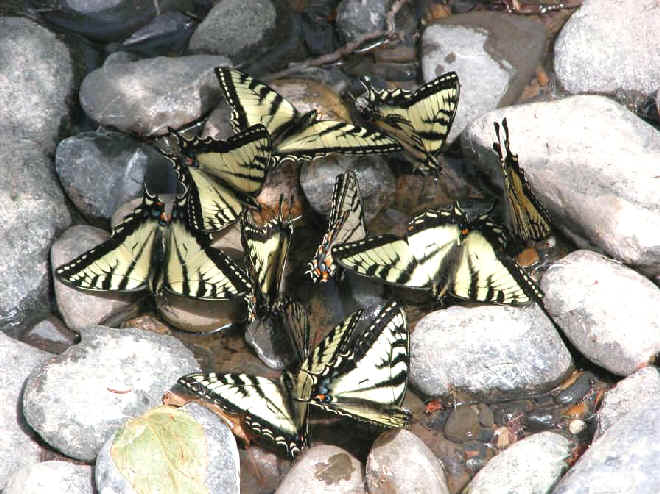
Canadian Tiger Swallowtails, puddling.
Photo taken in Quebec, Canada on the Gaspe Peninsula.
(photo by Howard Eskin)
- Appalachian Tiger Swallowtail ______
MD PA
Papilio appalachiensis
Adults feed at woodland flowers and at puddles.
- Spicebush Swallowtail (ph) ______
(PE:5) (K:27) (W:81) DE FL
MA
MD NC NH NJ PA VA may-sep
Papilio troilus
Although palatable, the Spicebush Swallowtail is one
of several butterflies of eastern North America (such as the dark form of
the female Eastern Tiger Swallowtail and the Red-spotted Purple
form of the White Admiral) that mimic, for their protection, the
toxic Pipevine Swallowtail (earlier in this list).
Host plants for caterpillars: primarily, as the name of the butterfly would
imply, Spicebush, Lindera benzoin. Also Sassafras, Sassifras
albidum, but
the larvae do better on Spicebush.
Adult food: thistle, milkweed, Joe-pye weed
In northern NJ: in 2015, during the Great Swamp Area Butterfly Count, on
July 5, there was 1 Spicebush Swallowtail.
In southern NJ: in 2015, during the Cumberland County Butterfly Count,
on June 24, there were 46 Spicebush Swallowtails.
In PA: in 2015, during the Hawk Mountain Butterfly Count, on July
11, there were 26 Spicebush Swallowtails.
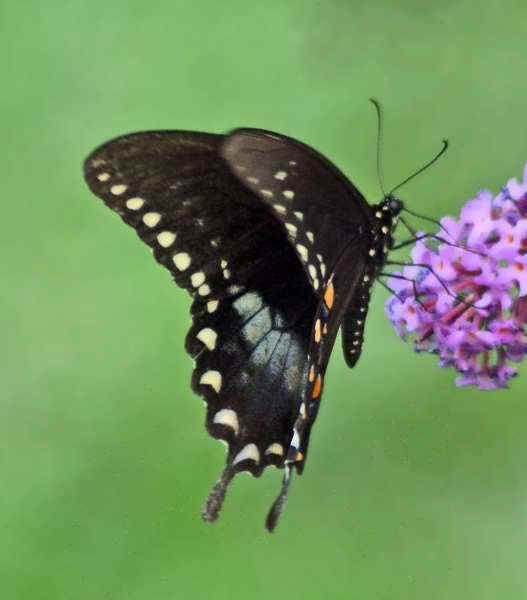
Above & below: Spicebush Swallowtail
(photos by Howard Eskin)
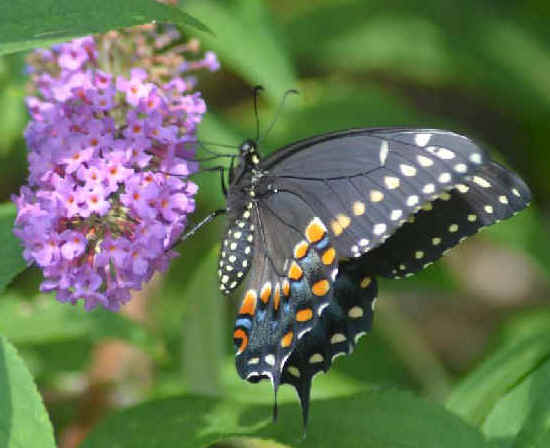
-
Black Swallowtail (ph) ______ (PE:5) (K:29)
(W:80) DE
FL MA
MD ME NC NH NJ PA VA apr-oct
Papilio polyxenes
Host plants for caterpillars:
in the Parsley/Carrot family, Apiaceae, such
as Queen Anne's Lace, Daucus carota.
On the Delmarva Peninsula, seems to prefer Fennel, Foeniculum vulgare.
Also cultivated plants: carrots, celery, caraway, dill, parsley.
The caterpillars feed on leaves or flowers.
Adult food: milkweed, thistle, Joe-pye weed
In northern NJ: in 2015, during the Great Swamp Area Butterfly Count, on
July 5, there were 5 Black Swallowtails.
In southern NJ: in 2015, during the Cumberland County Butterfly Count, on
June 24, there were 35 Black Swallowtails.
In PA: in 2015, during the Hawk Mountain Butterfly Count , on July
11, there were 5 Black Swallowtails.
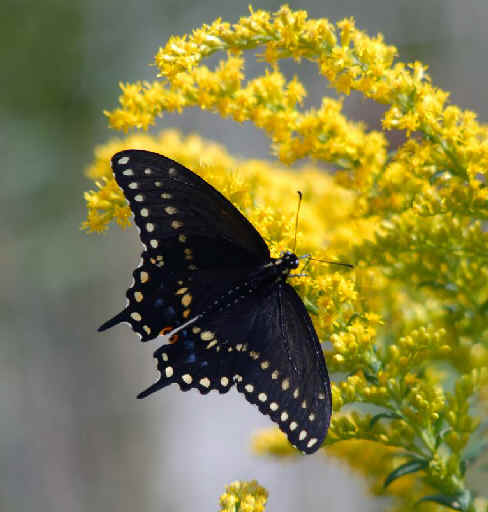
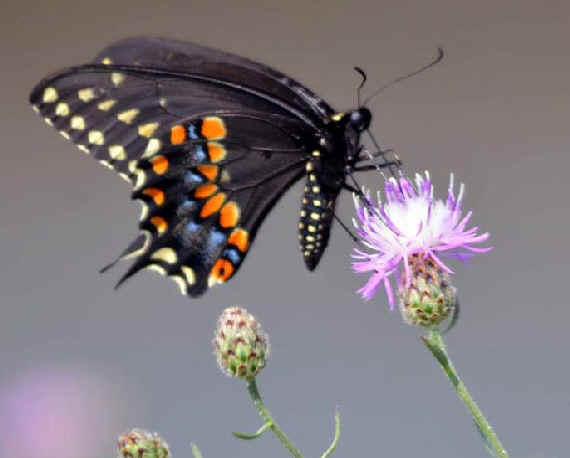
Above: Black Swallowtail butterflies
Below: the caterpillar of the Black Swallowtail
(upper photos by Howard Eskin; lower photo by Armas Hill)
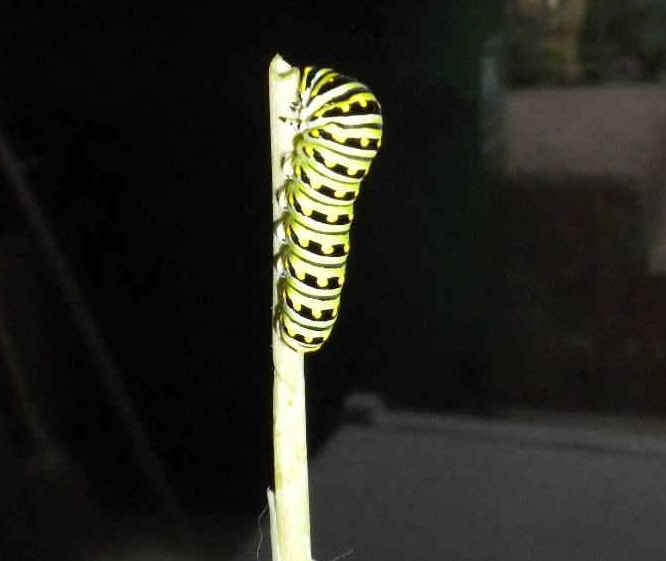
There is a similarity in color and pattern of the Black
Swallowtail caterpillar with that of the poisonous Monarch and Queen.
This Batesian mimicry may given the Black Swallowtail caterpillar
some protection from predators that have experienced either or both of the
other two species.
- Giant Swallowtail (ph) ______
(PE:6) (K:39) (W:78)
DE(rare) FL MA(has been
rare) MD(rare) NC
NH
NJ
PA VA
Papilio cresphontes
A name for the caterpillar of Papilio
cresphontes is Orange Dog.
The Giant Swallowtail was one of 12 southern butterfly species whose
population was found to have increased during a two-decade study in Massachusetts
released in August 2012.
There were numerous reports in 2011 & 2012 throughout the state, and it
may have bred. Earlier, in 2009 & 2010, there were a few sightings.
Between the years 2000 & 2008, there were none.
Historically, there was an incursion of the Giant Swallowtail in
the northeast US in the late 19th Century, in the 1870s & 1880s,
as chronicled by various entomologists.
In 1874, it was in Rye, New York, where it persisted for several
years.
In the 1870s, it was said to be "common" in the area of Berlin, Connecticut.
In the 1880s, it persisted at some upstate New York locations, and as
far north as Montreal in Canada. There were a few specimens taken in Massachusetts
in the 1880s, and one shortly after 1900.
In the early 20th Century, it was still reported regularly in Connecticut.
But by the 1930s the Giant Swallowtail had become rare throughout the
northeastern US, and remained so during the rest of the century.
The 1995-99 butterfly atlas project in Connecticut found none. The
2007 Rhode Island checklist classified the Giant Swallowtail
as "historical", but there were sightings there, singly, in
1983, 1984, 1985, and then again in September 2010.
Giant Swallowtails in Vermont (where now occurring in the
hundreds) are said to feed upon the Northern Prickly-ash, Zanthoxylem
americanum.
Other food plants for the species are the Garden Rue, Ruta
graveolens (an introduced herb, occurring north to Canada),
and the Common Hoptree, Ptelea trifoliata.
All of these plants are in the Rue, or Citrus Family, RUTACEAE.
Host plants for caterpillars: Rue (in Rutaceae), including
Common Rue, Ruta graveolus, also Wild Lime, Zanthoxylum fagara,
Hercules Club, Zanthoxylum clavaherculis, and Torchwood, Amyris
elemifera, Water Ash, Ptelea trifoliata.
And, in the southern part of the species' range, cultivated citrus (in the Citrus
genus).
Adult food: milkweed, goldenrod, and plants in the Rutaceae family
as noted above.
Notable: in southern NJ: 2012: Cape May Co Aug 12, Aug 21. Ocean Co Aug
30
in upstate NY: 2012: Crown Point May 20
in upstate NY: 2013: Lake Placid Aug 18, Paradox Lake Aug (date not known)
in upstate NY: 2014: Keene Aug 10, Onchiota Aug 10, Potsdam Aug 11, Glenville Aug 12, Lake
Placid Aug 12
in northern NJ: 2015: at Duke Farms Jul 25
in PA: 2015: upper Bucks County Aug 20 (a single)
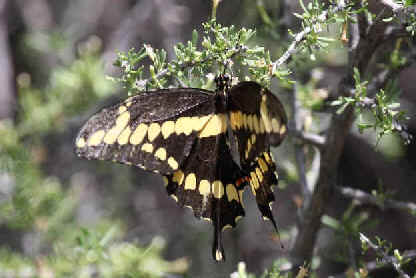
Giant Swallowtail
(photo by Marie Gardner)


 A
List and
A
List and 

![]()

















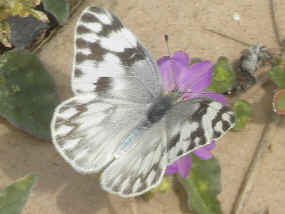

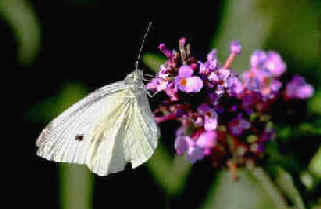
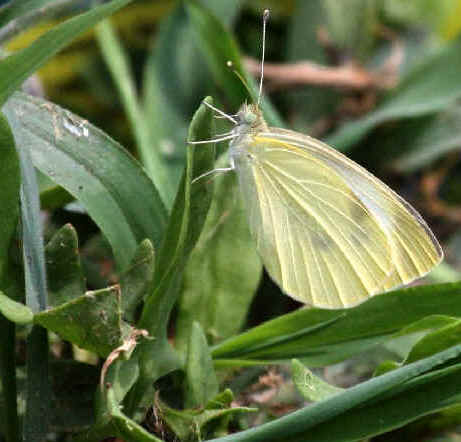
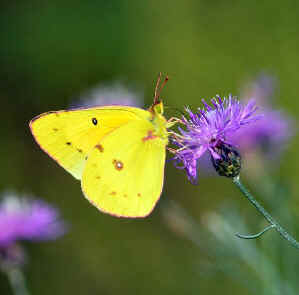

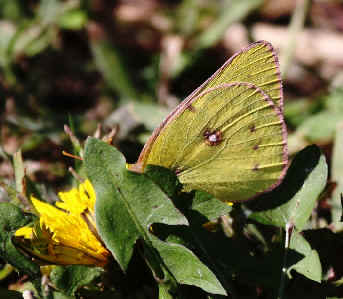
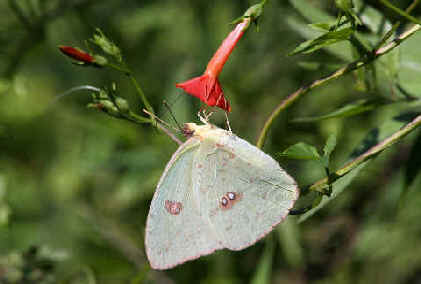
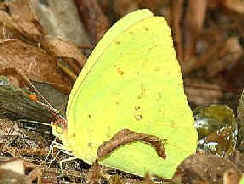
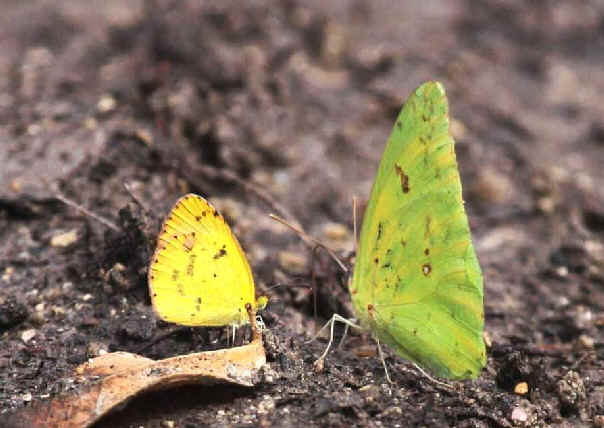
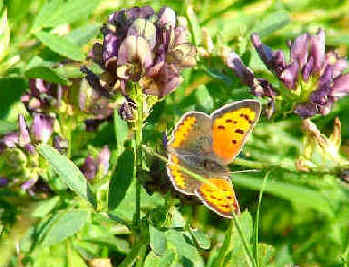
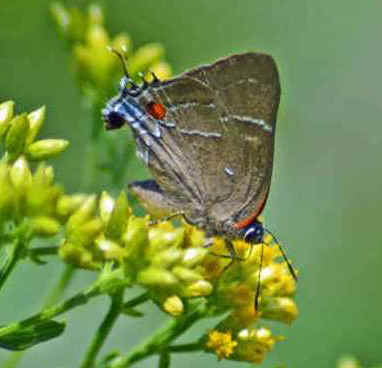
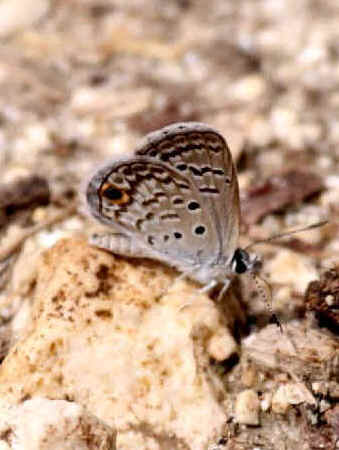
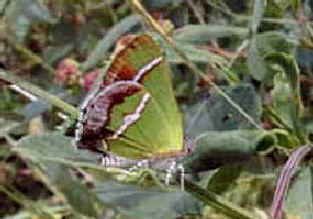
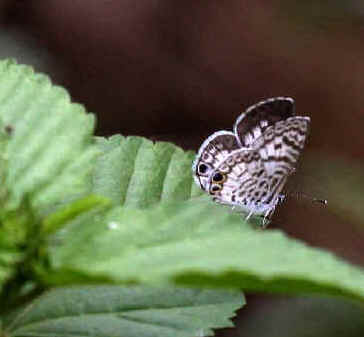
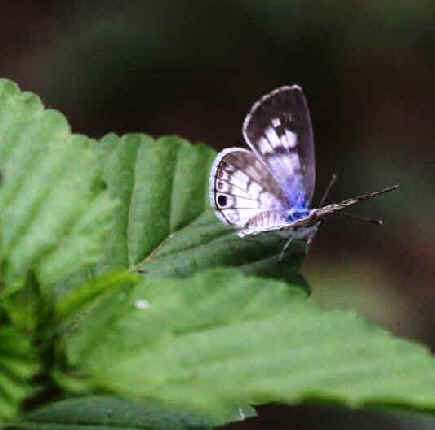
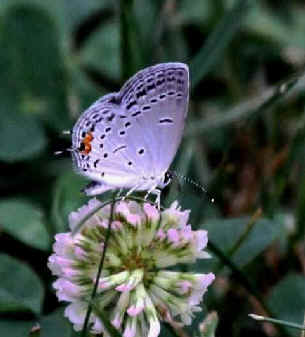


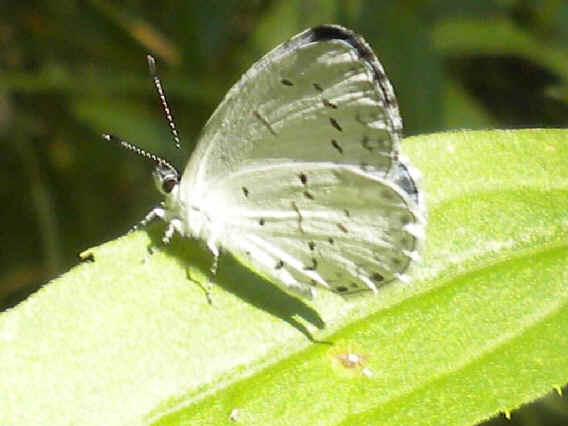
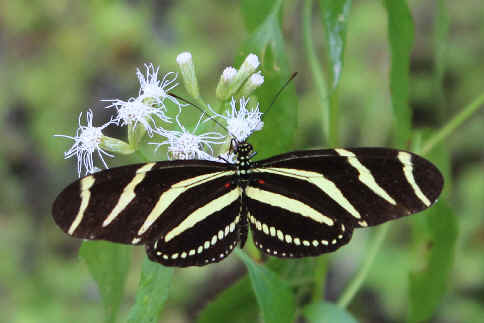
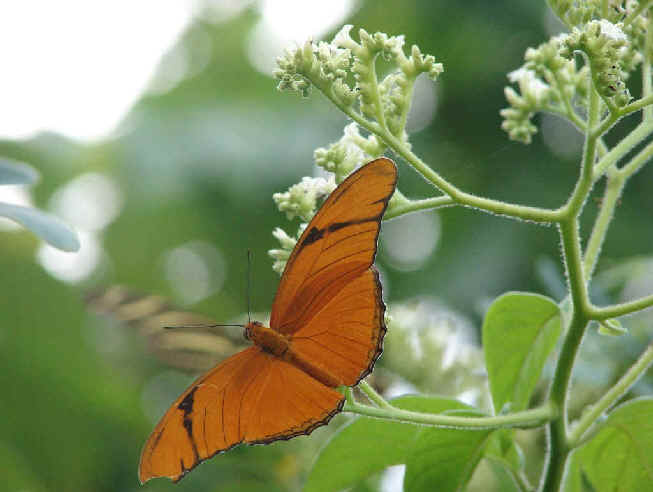
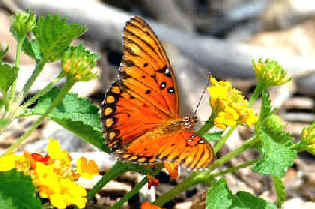
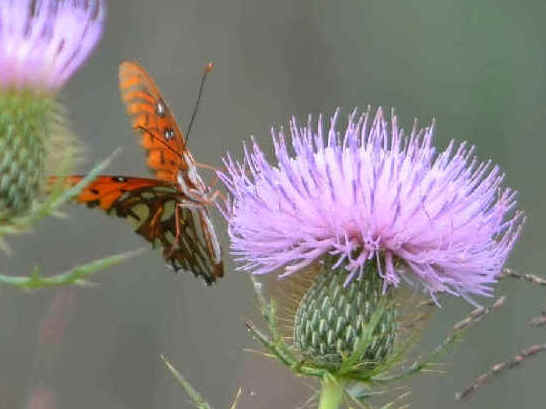
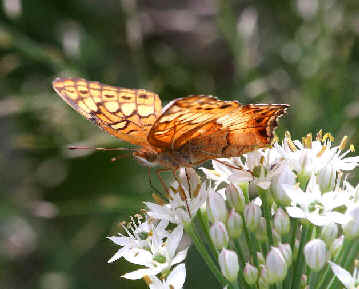
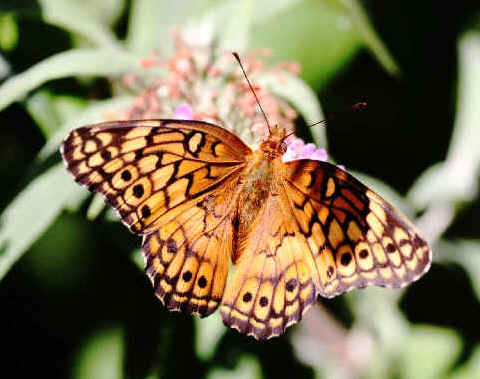
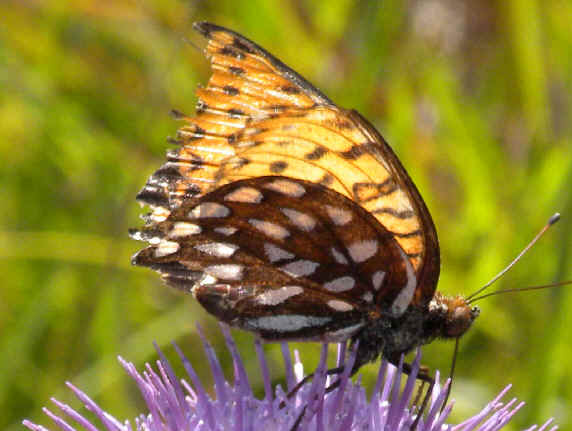
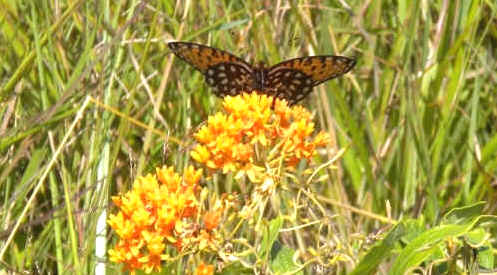
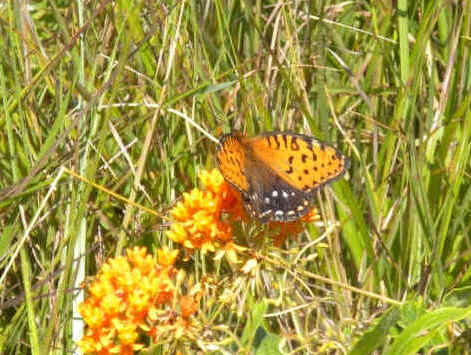
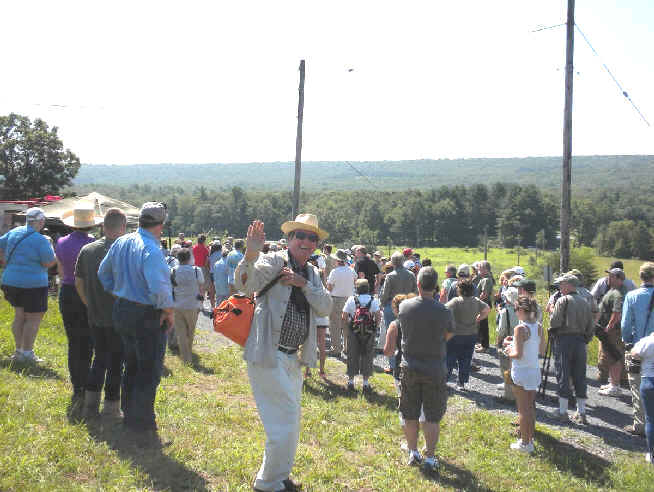
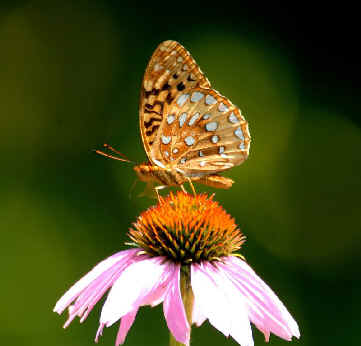
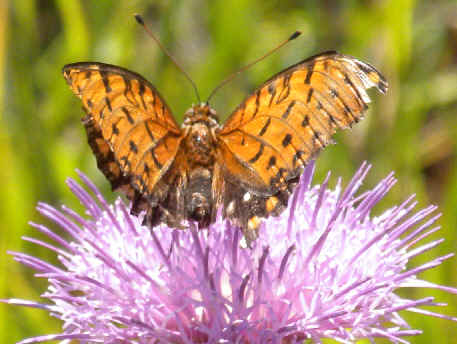
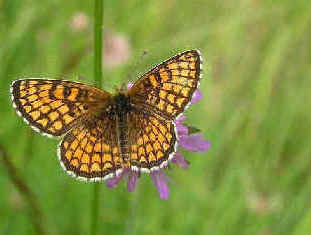

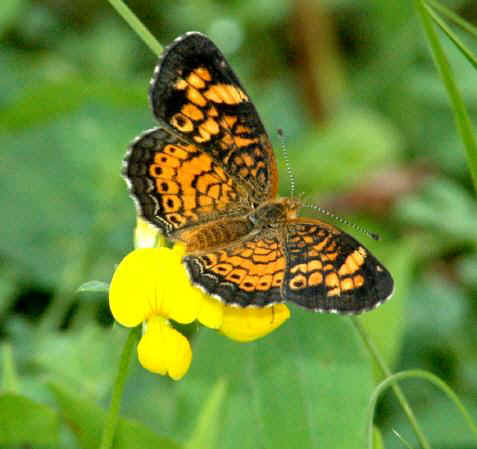
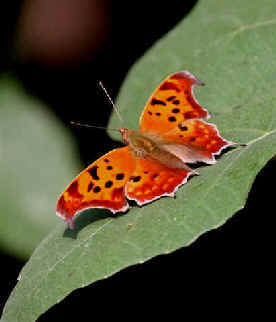
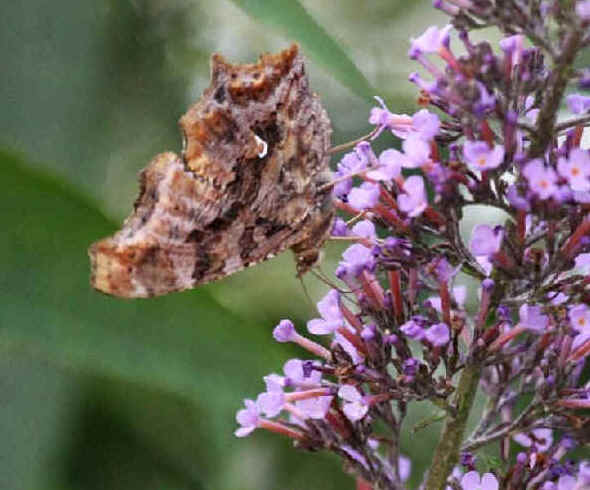

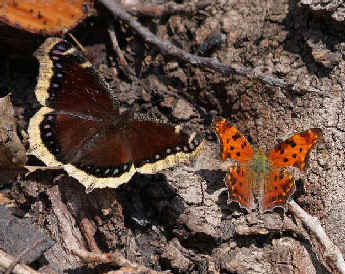

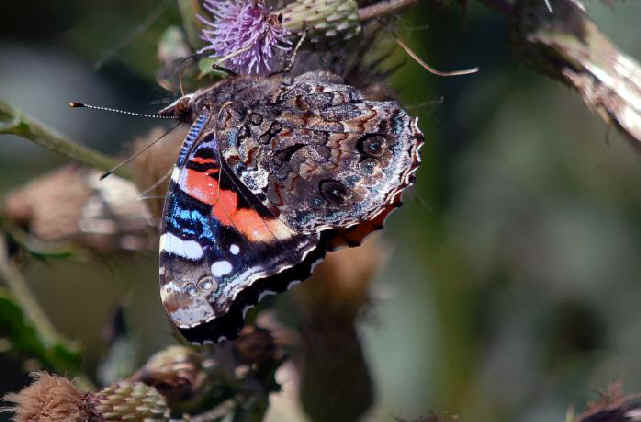
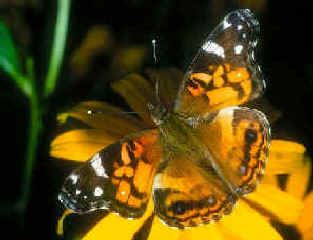
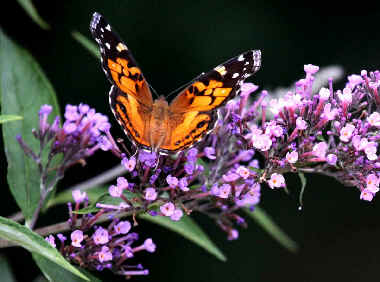
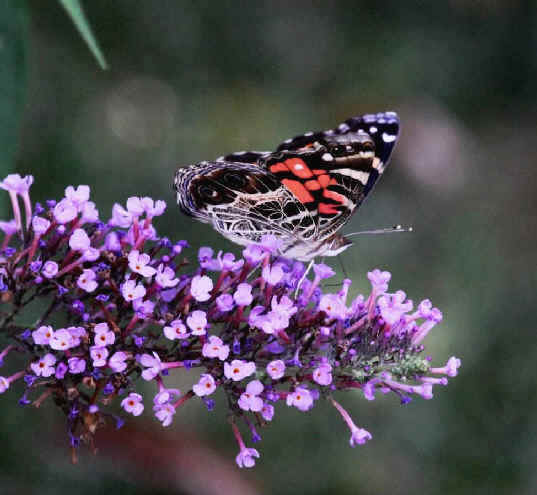
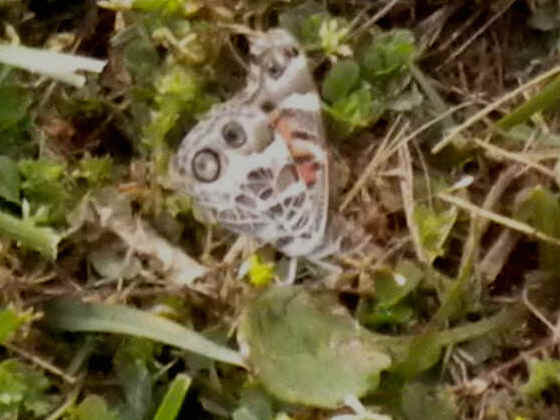
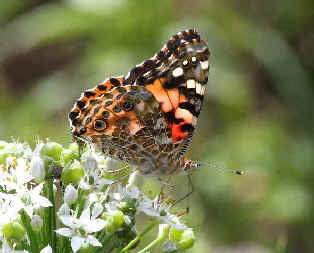
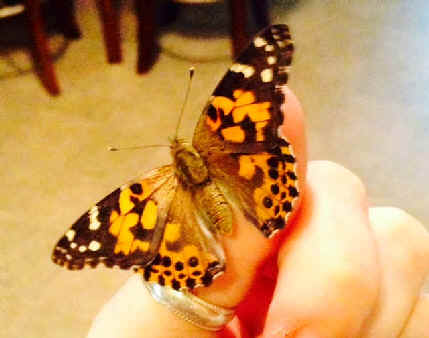
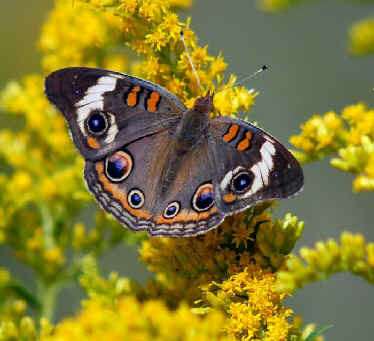
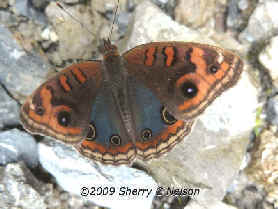
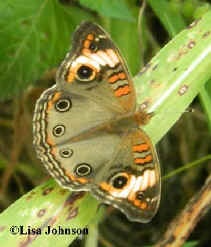
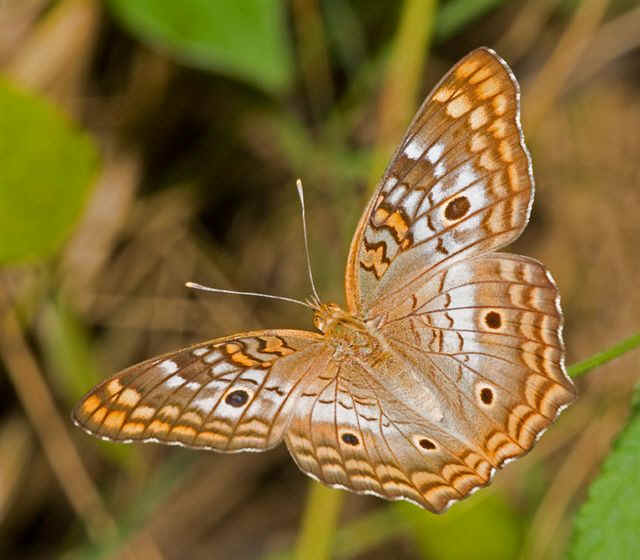
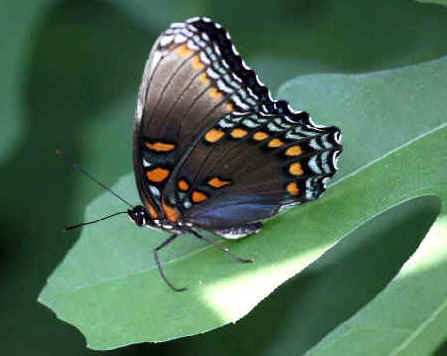
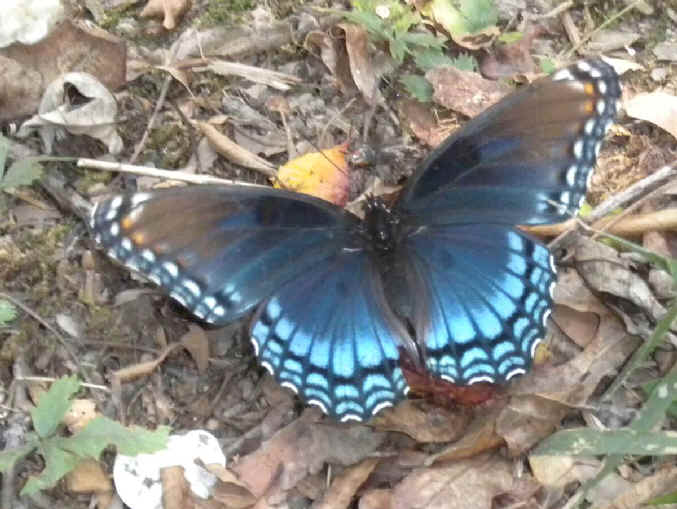
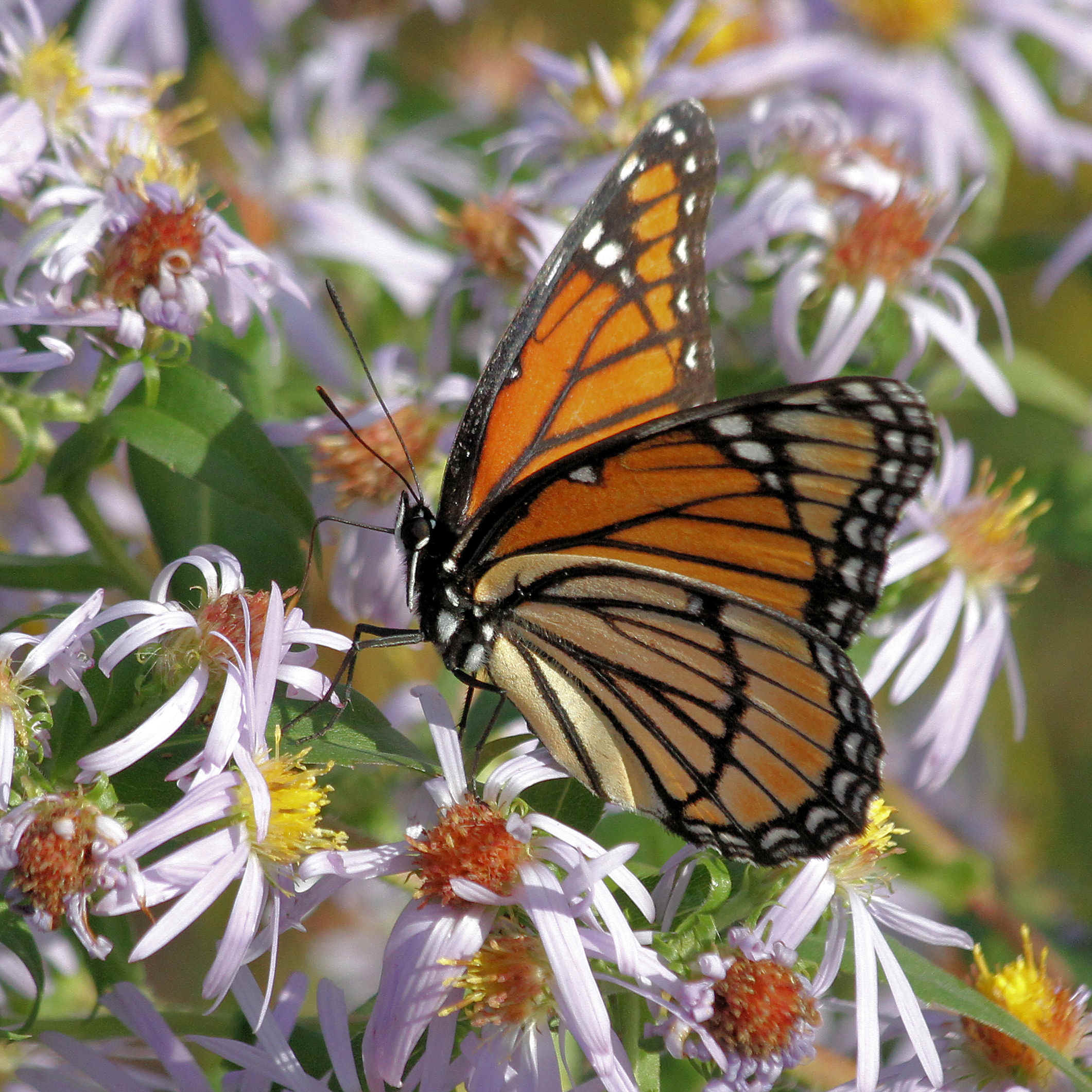
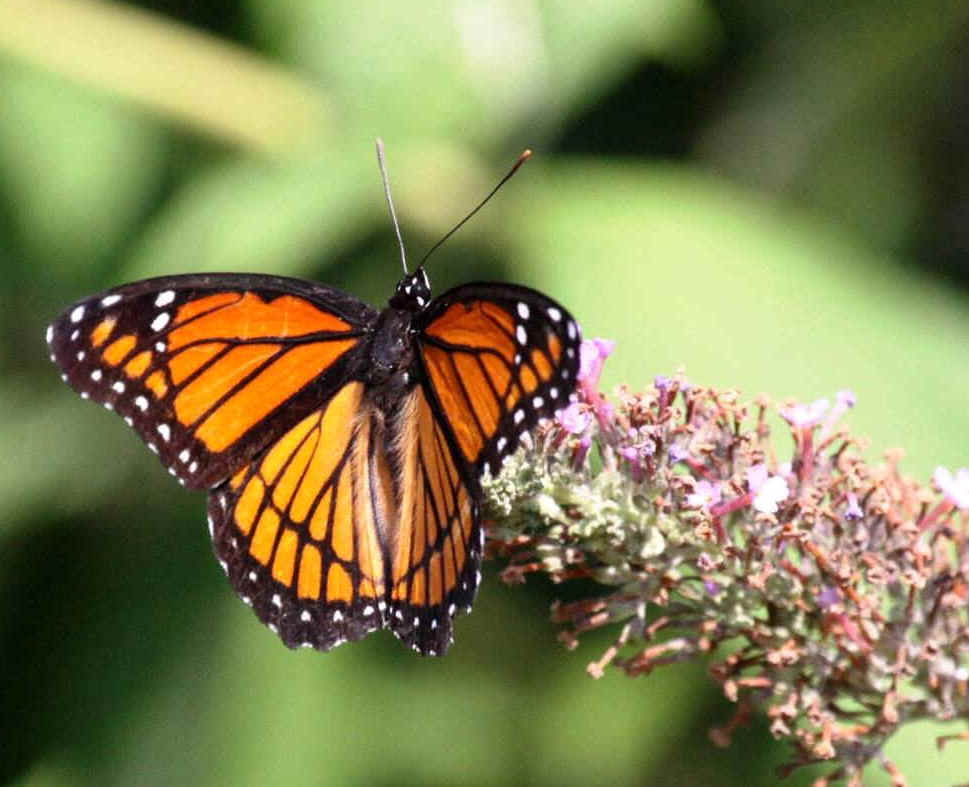
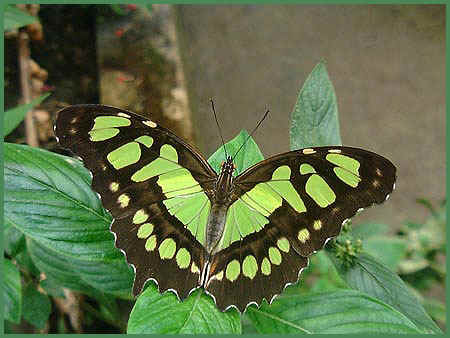
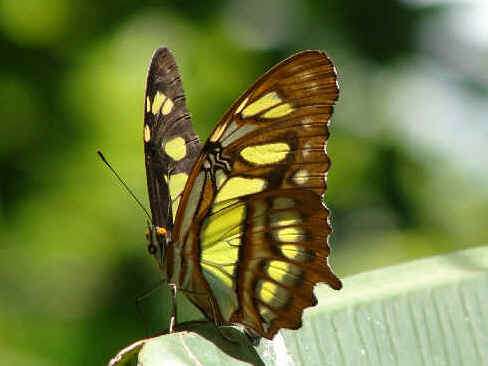
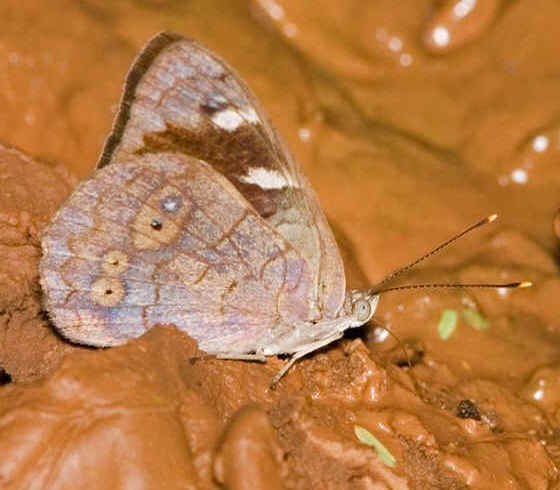

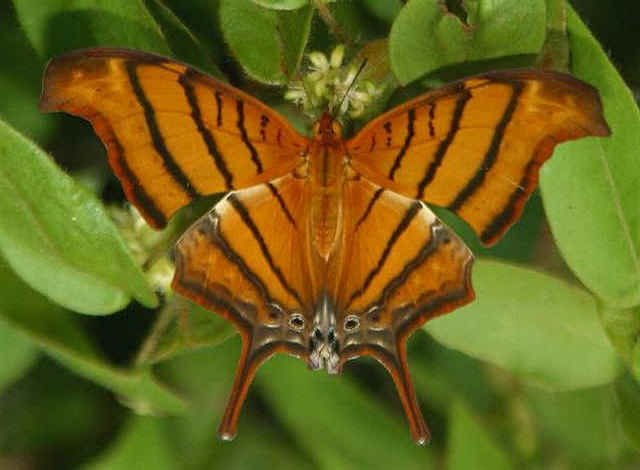
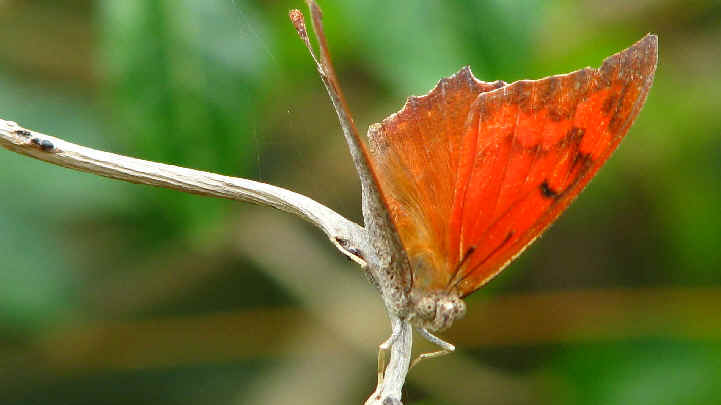

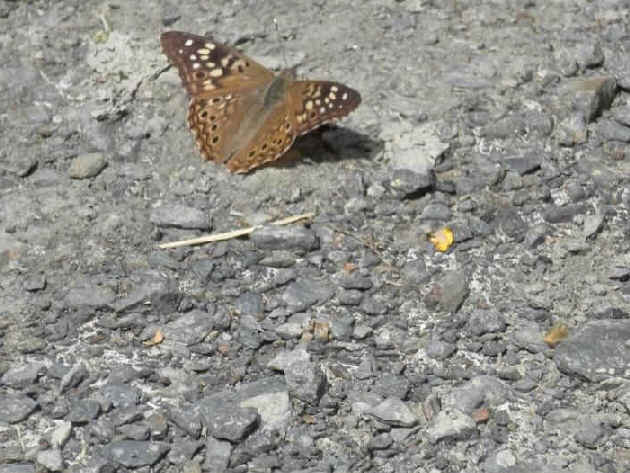
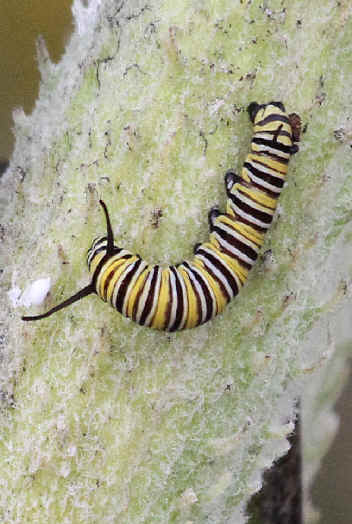
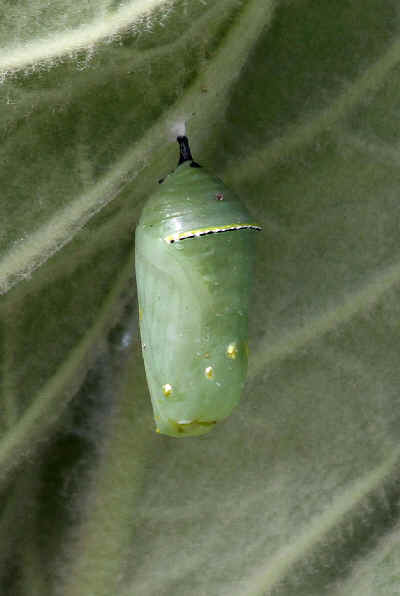
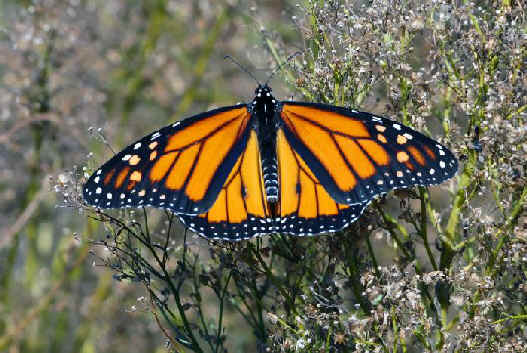
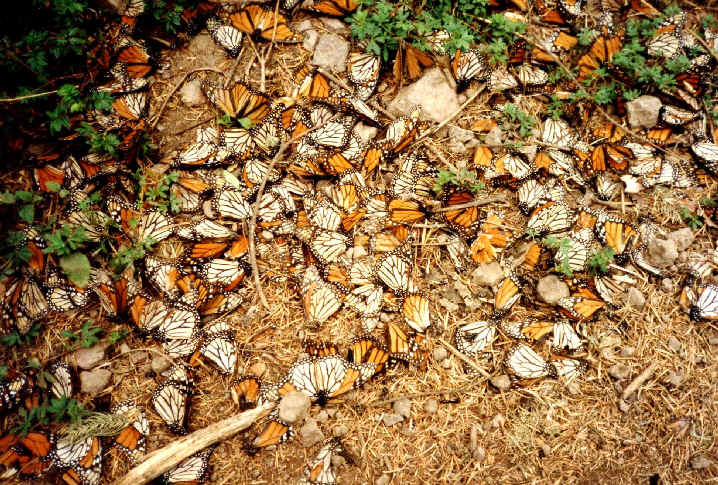
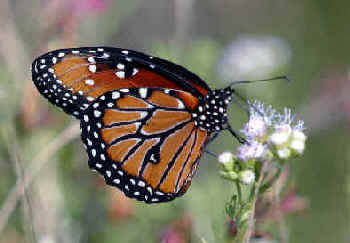

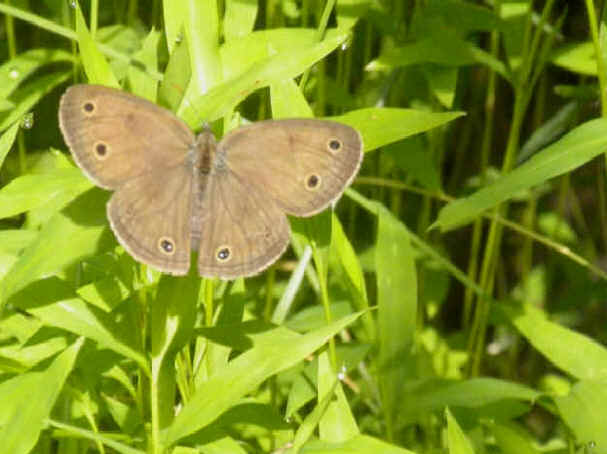
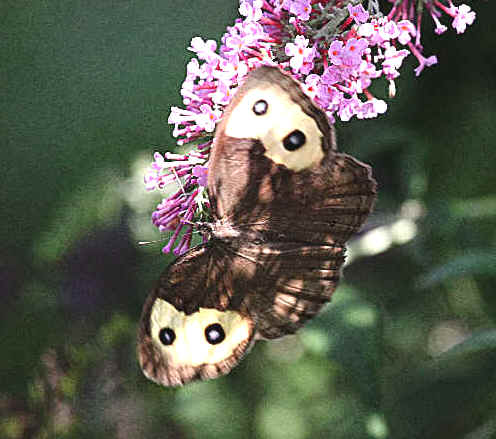
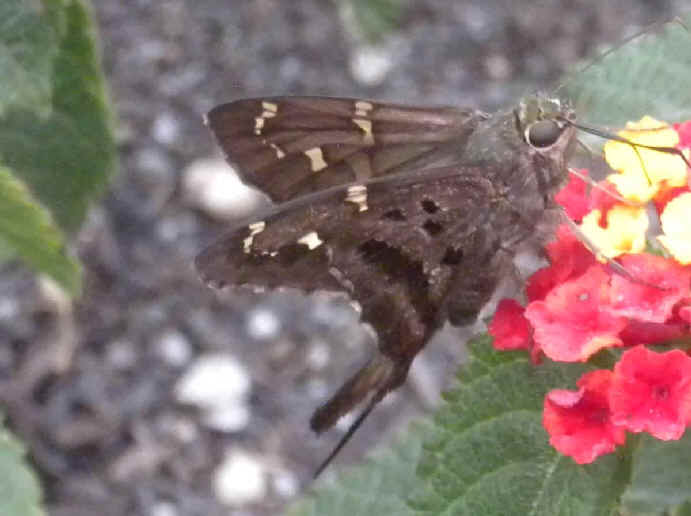
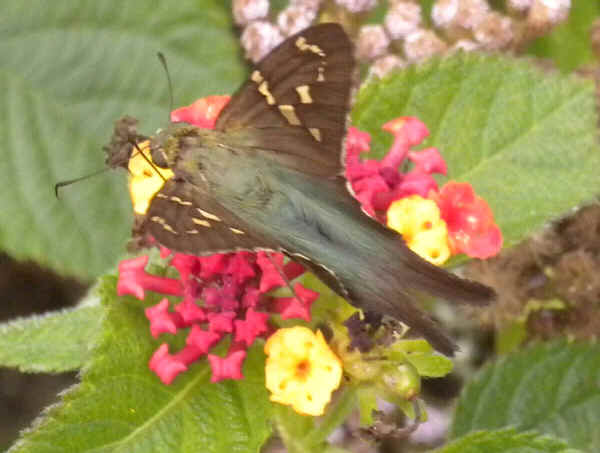
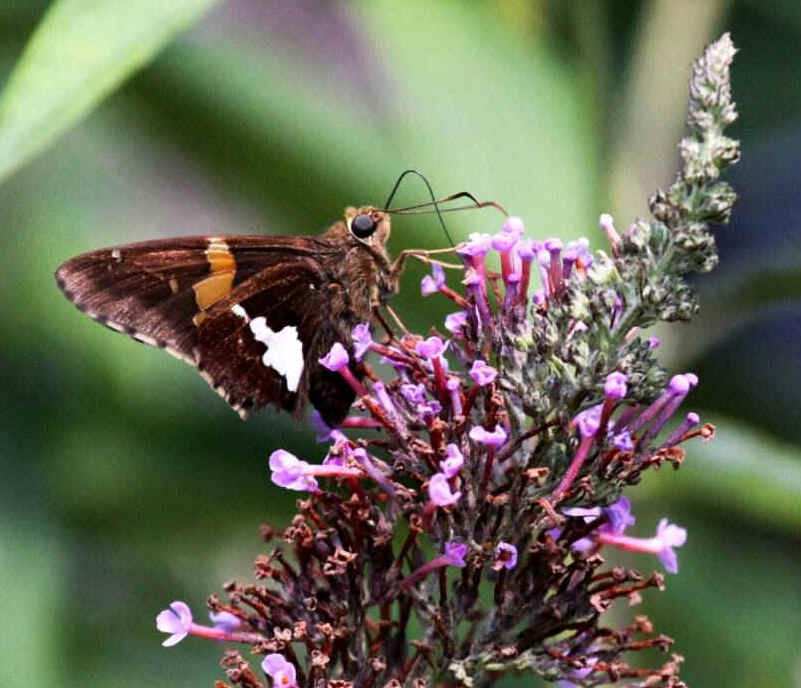
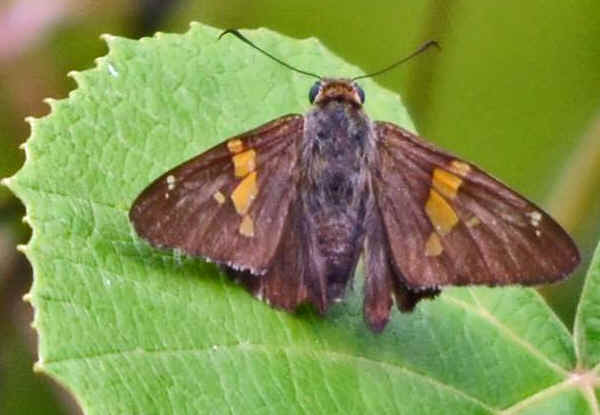
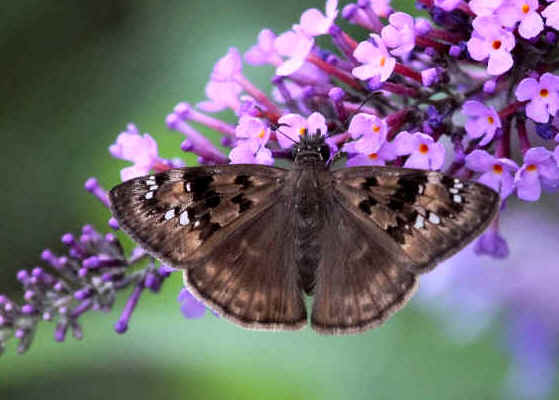

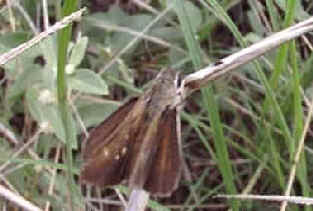
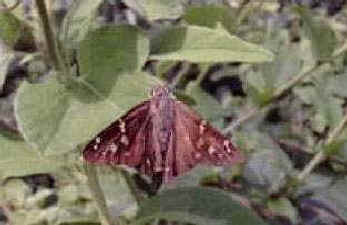
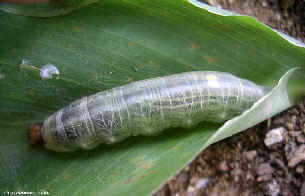
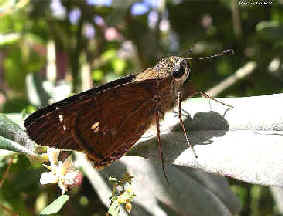
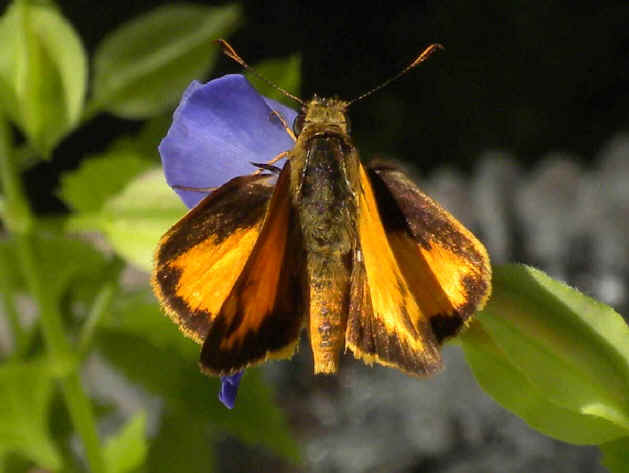
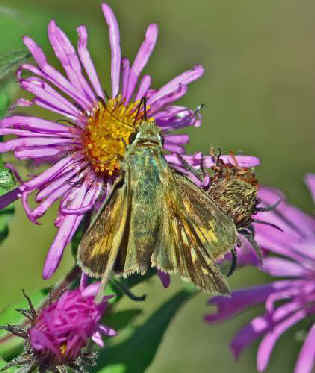

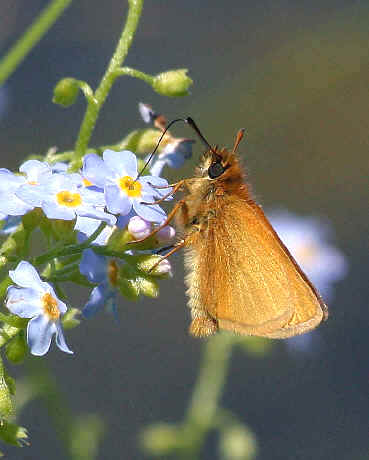
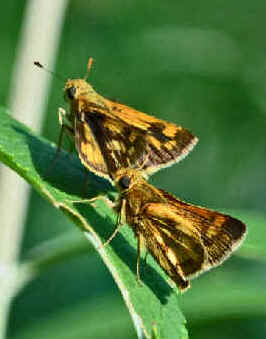
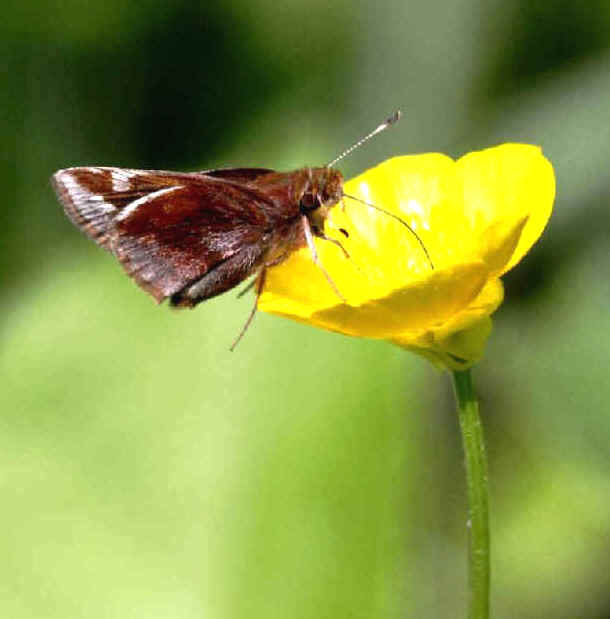

![]()